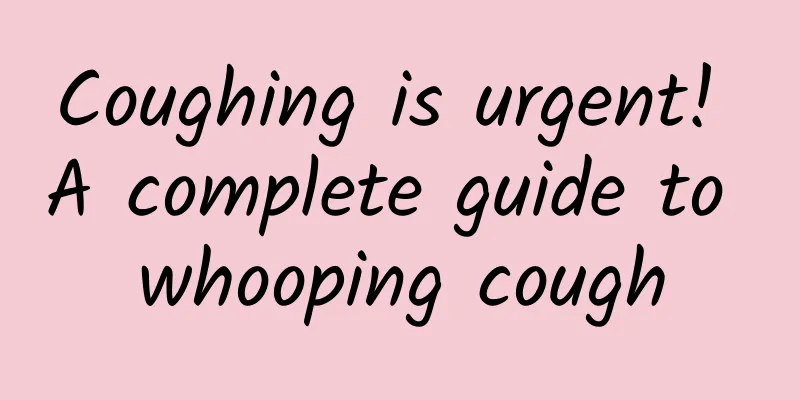Coughing is urgent! A complete guide to whooping cough

|
Author: Chen Zhou, attending physician at Shanghai Changhai Hospital Reviewer: Mei Xiaobin, Chief Physician, Shanghai Changhai Hospital Whooping cough, this term may be unfamiliar to people, but it is not uncommon in real life. When faced with whooping cough, many people are full of questions: What exactly is whooping cough? Will it threaten the health of me and my children? Do I need to be vaccinated? These questions are undoubtedly of great concern to every parent. Today, let's take a deep look at whooping cough. Figure 1 Copyright image, no permission to reprint 1. Who is the “culprit” of whooping cough? Whooping cough is an infectious disease caused by Bordetella pertussis, a Gram-negative short bacillus without flagella and unable to move autonomously, but it can produce a variety of virulence factors, especially pertussis toxin (PT), which is the key factor causing whooping cough. It is worth noting that Bordetella pertussis has relatively weak resistance to the outside world. It can be eliminated by heating at 56°C for 30 minutes, sun exposure for 1 hour, and drying for 3 to 5 hours. In addition, ultraviolet rays and general disinfectants can also effectively kill this bacteria. 2. How is whooping cough transmitted? Whooping cough is a highly contagious disease. Because immunity after vaccination gradually weakens over time, and Bordetella pertussis may mutate, the peak age of whooping cough in many countries around the world has shifted from infants to adolescents and adults. Therefore, we must realize that whooping cough is not limited to children, and adults can also be infected and have symptoms of persistent coughing. As an infectious disease, whooping cough is spread through the following three main routes: 1. Source of infection: Patients and carriers are the main sources of infection and are contagious from the incubation period to 6 weeks after onset of the disease (please keep a proper distance from people who cough). 2. Transmission route: Mainly through respiratory droplets, and can also be transmitted through close contact (wearing a mask and washing hands frequently are two major prevention methods). Figure 2 Copyright image, no permission to reprint 3. Susceptible population: All people are susceptible. Do not neglect prevention because you think you have strong immunity. 3. What are the clinical manifestations of whooping cough? The course of whooping cough is usually divided into three stages, each with its own characteristics: 1. Catarrhal stage (usually lasts 1 to 2 weeks): Symptoms are similar to those of the common cold, including runny nose, sneezing, coughing, sore throat, etc. There may be no fever or only a short-term fever. During this stage, the amount of bacteria excreted reaches its peak and the disease is highly contagious. 2. Spasmodic cough stage (usually lasts 2 to 6 weeks): The characteristic symptom is paroxysmal spasmodic cough, which is mild during the day and worsens at night, especially during sleep, affecting sleep quality. Adolescents or adults with pertussis usually do not have spasmodic coughs, but instead have paroxysmal coughs alternating with temporary relief. Figure 3 Copyright image, no permission to reprint 3. Recovery period: The cough gradually eases and the cock-crowing sound disappears. It may last for weeks or even months, proving that the saying of "coughing for a hundred days" is not groundless. 4. How to diagnose whooping cough? The diagnosis of pertussis requires a combination of epidemiological history, clinical manifestations, and laboratory tests. If any of the following symptoms are present, pertussis should be highly suspected: 1. Paroxysmal spasmodic cough, duration ≥ 2 weeks; 2. The infant has recurrent episodes of apnea, choking, cyanosis, and bradycardia; 3. Cough lasting for more than 2 weeks in older children, adolescents, and adults, without fever. Laboratory tests mainly include routine blood tests, pathogen tests and serological tests. If Bordetella pertussis is found in pathogen or serological tests, pertussis can be diagnosed. 5. What are the treatments for whooping cough? The treatment of whooping cough mainly includes general treatment, pathogen treatment and complication treatment. The treatment needs to be performed by professional doctors, and patients and their families should fully understand the condition so as to better cooperate with the treatment. 1. General treatment: Isolate according to respiratory infectious diseases. Give nutritious and easily digestible food, and appropriately supplement vitamins and calcium. Patients with severe spasmodic cough can be fed through the nasogastric tube to avoid aspiration, suffocation and aspiration pneumonia. 2. Antibiotic treatment: Macrolide antibiotics are preferred, such as azithromycin, erythromycin, clarithromycin, etc. Please note that the above drugs are prescription drugs and must be used under the guidance of a doctor. 3. Treatment of complications: Provide appropriate treatment for secondary complications such as bacterial pneumonia, encephalitis, etc. 4. TCM treatment: The core pathogenesis of whooping cough is the combination of external epidemic and internal phlegm, which blocks the airway and causes the lung qi to rise. It is recommended to consult a professional TCM doctor for syndrome differentiation and treatment. 6. How to prevent whooping cough? The most important measure to prevent whooping cough is vaccination. The vaccine currently used in my country is a triple vaccine consisting of diphtheria toxoid, acellular pertussis vaccine, and tetanus toxoid (DTaP). Infants are vaccinated with one dose each at 3 months, 4 months, 5 months, and 18 months of age. Because the level of protective antibodies decreases 3 to 5 years after vaccination and almost disappears after 12 years, adolescents and adults should also receive regular booster vaccinations. In addition, the following preventive measures should be taken: Figure 4 Copyright image, no permission to reprint 1. Adequate isolation: Respiratory tract isolation until 5 days after effective antibiotic treatment; for patients who are not given effective antibiotic treatment in time, the isolation period is 21 days after spasmodic cough. 2. Maintain good personal hygiene habits, such as washing hands frequently and wearing masks. 3. For close contacts, post-exposure prophylaxis is recommended, that is, receiving drug prevention or emergency vaccination within 21 days after exposure (as early as possible). Summarize Although whooping cough is an ancient disease, with the help of modern medicine, we are fully capable of effectively preventing and treating it. I hope that through the popularization of this article, everyone can have a deeper understanding of whooping cough and take appropriate measures to protect the health of themselves and their families. Let us work together to create a world without whooping cough! References: [1] National Health Commission, Pertussis Diagnosis and Treatment Program (2023 Edition) [2]Pertussis infection in infants and children: Clinical features and diagnosis. Uptodate, 2024. [3] Pertussis infection in adolescents and adults: Treatment and prevention. Uptodate, 2024. |
Recommend
What is the number of births in 2021? The 2021 population data of 15 provinces is released!
On February 28, the National Bureau of Statistics...
Google just released a tool to crack into your iPhone
Google released a powerful tool this morning to h...
Payment logic: Why should users give you money?
In this world, it is not easy for a person to mak...
Community operation: the key point to keep the community active!
I ate and drank too much in the first half of the...
#千万IP创科普# Dangers often occur in travel and exploration! Remind again →
Golden Week Day 5 of Vacation Mode Friends are ce...
Mobile phones are so far ahead, it turns out that satellites are the scapegoat
Comes with satellite phone! Ahead of the curve! T...
Honda China: Honda China sales in January 2025 were 68,890 units, down 31.8% year-on-year
Recently, Honda China released its January sales ...
"Giant sunspots suddenly appear on the sun's surface", could it paralyze the phone network? Is the danger really approaching the earth?
Not long ago, a piece of news about a "huge ...
It's been ten years. What else can you do besides watching TV series on your iPad?
When Jobs entered, there was a leather sofa and a...
Whose company is Alibaba?
Last Friday, Alibaba was listed on the New York S...
4 steps to solve the advertising problem, analysis of advertising strategies in the wedding photography industry!
Target: A national wedding photography chain clie...
Heavy games are becoming a general trend. TBG offline salon offers suggestions for the development of TV games
In 2015, the popularity of "smart" and ...
What functions does a hotel management mini program need?
As we all know, mini programs are divided into fr...
Light soy sauce, dark soy sauce, chicken essence and MSG...what are the differences between various seasonings?
Mixed Knowledge Specially designed to cure confus...
I am a terrifying snake, but I am about to become a meal! | Expo Daily
Snake, I'm about to become a meal Environment...









